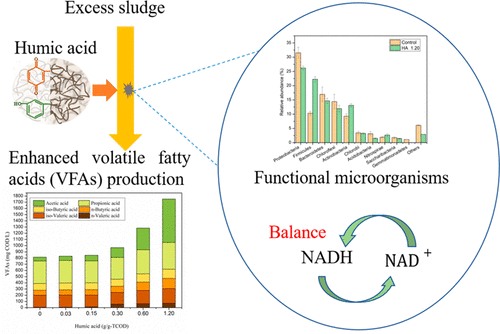当前位置:
X-MOL 学术
›
ACS Sustain. Chem. Eng.
›
论文详情
Our official English website, www.x-mol.net, welcomes your
feedback! (Note: you will need to create a separate account there.)
Humic Acid Promotes Volatile Fatty Acids Production from Excess Sludge in Anaerobic Fermentation
ACS Sustainable Chemistry & Engineering ( IF 7.1 ) Pub Date : 2021-09-07 , DOI: 10.1021/acssuschemeng.1c02790 Jiali Zou 1 , Gongxia Li 2 , Dayang Zheng 1 , Yayi Wang 1 , Cang Feng 1 , Yue Sun 1 , Maoling Juan 1 , Xinxing Bai 1 , Min Wu 1
ACS Sustainable Chemistry & Engineering ( IF 7.1 ) Pub Date : 2021-09-07 , DOI: 10.1021/acssuschemeng.1c02790 Jiali Zou 1 , Gongxia Li 2 , Dayang Zheng 1 , Yayi Wang 1 , Cang Feng 1 , Yue Sun 1 , Maoling Juan 1 , Xinxing Bai 1 , Min Wu 1
Affiliation

|
Excess sludge was used to produce volatile fatty acids (VFAs) by fermentation, which has recently attracted much attention because the sludge-derived VFAs were able to function as a kind of ideal carbon source for wastewater biological treatment. This study specifically targeted the mechanism behind the effects of humic acid (HA) on promoting production of VFAs from excess sludge during acidogenic fermentation. The HA was characterized using Fourier-transform infrared (FTIR) spectrum, 13C nuclear magnetic resonance (13C NMR), and 3D excitation–emission matrix (3D-EEM). When HA was present at 1.20 g/g of total chemical oxygen demand, the content of VFAs produced was maximal (1752 mg COD/L) and was about 2.15 times that of the control without HA (815 mg/L). Mechanism exploration revealed that the dominant population of microbial community in the sample with added HA had shifted to Firmicutes, which was related to the acid production. More importantly, the electron transfer between nicotinamide adenine dinucleotide hydrogen (NADH) and nicotinamide adenine dinucleotide (NAD+) was enhanced by HA, contributing to improve the VFAs’ accumulation. In contrast, the activities of the key enzymes, including acetic kinase (AK) and phosphotransferase (PTA), in the acidogenic stage had little change with HA addition, which meant that HA could not stimulate acidification by the way of changing enzymatic activities.
中文翻译:

腐植酸促进厌氧发酵中过量污泥产生挥发性脂肪酸
利用剩余污泥通过发酵生产挥发性脂肪酸(VFAs),最近引起了广泛关注,因为污泥衍生的 VFAs 能够作为一种理想的废水生物处理碳源。本研究专门针对腐植酸 (HA) 在产酸发酵过程中促进从剩余污泥中产生 VFA 的影响背后的机制。HA 使用傅里叶变换红外 (FTIR) 光谱、13 C 核磁共振 ( 13C NMR)和 3D 激发-发射矩阵(3D-EEM)。当 HA 以 1.20 g/g 的总化学需氧量存在时,产生的 VFA 含量最高(1752 mg COD/L),是不含 HA 的对照(815 mg/L)的 2.15 倍。机制探索表明,添加 HA 的样品中微生物群落的优势种群已转移到厚壁菌门,这与产酸有关。更重要的是,烟酰胺腺嘌呤二核苷酸氢(NADH)和烟酰胺腺嘌呤二核苷酸(NAD +) 被 HA 增强,有助于改善 VFA 的积累。相比之下,酸化阶段的关键酶包括乙酸激酶(AK)和磷酸转移酶(PTA)的活性随着HA的加入几乎没有变化,这意味着HA不能通过改变酶活性的方式刺激酸化。
更新日期:2021-09-20
中文翻译:

腐植酸促进厌氧发酵中过量污泥产生挥发性脂肪酸
利用剩余污泥通过发酵生产挥发性脂肪酸(VFAs),最近引起了广泛关注,因为污泥衍生的 VFAs 能够作为一种理想的废水生物处理碳源。本研究专门针对腐植酸 (HA) 在产酸发酵过程中促进从剩余污泥中产生 VFA 的影响背后的机制。HA 使用傅里叶变换红外 (FTIR) 光谱、13 C 核磁共振 ( 13C NMR)和 3D 激发-发射矩阵(3D-EEM)。当 HA 以 1.20 g/g 的总化学需氧量存在时,产生的 VFA 含量最高(1752 mg COD/L),是不含 HA 的对照(815 mg/L)的 2.15 倍。机制探索表明,添加 HA 的样品中微生物群落的优势种群已转移到厚壁菌门,这与产酸有关。更重要的是,烟酰胺腺嘌呤二核苷酸氢(NADH)和烟酰胺腺嘌呤二核苷酸(NAD +) 被 HA 增强,有助于改善 VFA 的积累。相比之下,酸化阶段的关键酶包括乙酸激酶(AK)和磷酸转移酶(PTA)的活性随着HA的加入几乎没有变化,这意味着HA不能通过改变酶活性的方式刺激酸化。











































 京公网安备 11010802027423号
京公网安备 11010802027423号